Study on the Influence of Mounting Dimensions of PV Array on Module Temperature in Open-Joint Photovoltaic Ventilated Double-Skin Façades
Abstract
:1. Introduction
2. Description of Methodology
2.1. Basic Theory and Equation
2.2. Description of Computational Fluid Dynamics (CFD) Modeling
2.3. Experimental Model
2.4. Analysis of Experimental Results
2.4.1. Comparison with Measured Temperature
2.4.2. Comparison of the Temperature Field with Thermography
3. Simulation of Modules Temperature at Different Mounting Dimensions
3.1. Introduction to the Mounting Dimensions (MD) of the Open-Joint
3.2. The Distance between Photovoltaic (PV) Modules and Wall
3.3. The Distance between Two Adjacent PV Modules in the Vertical Direction
3.4. The Distance between Two Adjacent PV Modules in the Horizontal Direction
4. Conclusions
- (1)
- The MDs of PV do have a large influence on the temperature of the PV modules. When the ratio between the distance between the module and wall and the length of the module in the vertical direction changes from 0.05 to 0.15, the temperature drop of the PV module is the most obvious, reaching 2.0 K, and with the value of a is further increased, the temperature change of the PV modules is small.
- (2)
- When the ratio of the distance between two adjacent PV modules in the vertical direction and the length of the module in the vertical direction (defined as b value) is changed from 0 to 0.1, the temperature drop of the PV module is most obvious, reaching 1.1 K. When the ratio of the distance between two adjacent PV modules in the horizontal direction and the length of the module in the horizontal direction (defined as c value) is changed from 0 to 0.1, the temperature of the PV module is lowered by 0.8 K, and when c is further increased, the temperature change of the PV array is not significant.
- (3)
- It is recommended to maintain the three-dimension factor a, b, and c of the PV array at 0.1–0.15, 0.1, and 0.1, respectively, thereby improving the energy efficiency of integrated PV buildings.
Author Contributions
Funding
Institutional Review Board Statement
Informed Consent Statement
Data Availability Statement
Acknowledgments
Conflicts of Interest
Appendix A
| Abbreviation | Meaning |
|---|---|
| MD | Mounting dimensions (in this paper, it means the distance between PV modules and walls, and the distance between tow modules adjacent in the vertical or horizontal direction in PV arrays on the surface of the building façade) |
| PV | Photovoltaic |
| PV-DSF | PV double skin façades |
| CFD | Computational fluid dynamics |
| OJVF | Open-joint ventilated façade |
| OJ-PV-DSF | Open-joint PV ventilated double skin façades |
| DO | Discrete Ordinates |
| RNG | Renormalization-group |
| Symbols | Meaning |
|---|---|
| a | the ratio of the distance between PV modules and the wall to the vertical length of PV modules |
| b | the ratio of the distance between two adjacent PV modules in the vertical direction and the length of PV modules in the vertical direction |
| c | the ratio of the distance between two adjacent PV modules in the horizontal direction and the width of PV modules in the horizontal direction |
| D | the distance between PV modules and the wall |
| Hg | the distance between two adjacent PV modules in the vertical direction |
| H | the Length of PV module in vertical direction |
| H’ | the height of the wall |
| W | the width of the wall |
| Lg | the distance between two adjacent PV modules in the horizontal direction |
| L | the width of PV modules in the horizontal direction |
References
- Weiding, L. Thinking on building energy efficiency 2.0. HV&AC 2016, 48, 1–12. [Google Scholar]
- Building Energy Research Center, Tsinghua University. 2018 Annual Report on China Building Energy Efficiency; China Architecture & Building Press: Beijing, China, 2018. [Google Scholar]
- Lai, C.-M.; Hokoi, S. Solar façades: A review. Build. Environ. 2015, 91, 152–165. [Google Scholar] [CrossRef]
- Ji, J.; Yu, Z.; Sun, W.; Chen, H.; Cai, J. Study of multiple solar technologies integrated with building. Acta Energ. Sol. Sin. 2016, 37, 489–493. [Google Scholar]
- Siecker, J.; Kusakana, K.; Numbi, B. A review of solar photovoltaic systems cooling technologies. Renew. Sustain. Energy Rev. 2017, 79, 192–203. [Google Scholar] [CrossRef]
- Wysocki, J.J.; Rappaport, P. Effect of temperature on photovoltaic solar energy conversion. J. Appl. Phys. 1960, 31, 571–578. [Google Scholar] [CrossRef]
- Friedrich, S.; Thomas, E. Photovoltaics in Buildings; Taylor and Francis: Oxfordshire, UK, 1996. [Google Scholar]
- Yang, H.; Lv, L.; Peng, J.; Zhou, W. Solar Building Integration Technology and Application; China Architec-Ture & Building Press: Beijing, China, 2015. [Google Scholar]
- Wang, M.; Peng, J.; Li, N.; Yang, H.; Wang, C.; Li, X.; Lu, T. Comparison of energy performance between PV double skin façades and PV insulating glass units. Appl. Energy 2017, 194, 148–160. [Google Scholar] [CrossRef]
- Yang, H.; Ji, J. Study on the heat gain of a PV-wall. Acta Energ. Sol. Sin. 1999, 20, 270–273. [Google Scholar]
- Jie, J. The annual analysis of the power output and heat gain of a PV-wall with different integration mode in Hong Kong. Sol. Energy Mater. Sol. Cells 2002, 71, 435–448. [Google Scholar] [CrossRef]
- Fossa, M.; Ménézo, C.; Leonardi, E. Experimental natural convection on vertical surfaces for building integrated photovoltaic (BIPV) applications. Exp. Therm. Fluid Sci. 2008, 32, 980–990. [Google Scholar] [CrossRef]
- Fatnassi, S.; Ben Maad, R.; Abidi-Saad, A.; Polidori, G. On the appearance of natural convection induced reversed flow: Precocious hydrodynamic experimental study; Application to PV-DSF systems. Appl. Therm. Eng. 2017, 127, 1598–1607. [Google Scholar] [CrossRef]
- Agathokleous, R.A.; Kalogirou, S.A. Double skin façades (DSF) and building integrated photovoltaics (BIPV): A review of configurations and heat transfer characteristics. Renew. Energy 2016, 89, 743–756. [Google Scholar] [CrossRef]
- Zöllner, A.; Winter, E.; Viskanta, R. Experimental studies of combined heat transfer in turbulent mixed convection fluid flows in double-skin-façades. Int. J. Heat Mass Transf. 2002, 45, 4401–4408. [Google Scholar] [CrossRef]
- Peng, J.; Lu, L.; Yang, H.; Han, J. Investigation on the annual thermal performance of a photovoltaic wall mounted on a multi-layer façade. Appl. Energy 2013, 112, 646–656. [Google Scholar] [CrossRef]
- Peng, J.; Lu, L.; Yang, H. An experimental study of the thermal performance of a novel photovoltaic double-skin facade in Hong Kong. Sol. Energy 2013, 97, 293–304. [Google Scholar] [CrossRef]
- Kaiser, A.; Zamora, B.; Mazón, R.; García, J.; Vera, F. Experimental study of cooling BIPV modules by forced convection in the air channel. Appl. Energy 2014, 135, 88–97. [Google Scholar] [CrossRef]
- Lau, S.K.; Zhao, Y.; Shabunko, V. Optimization and Evaluation of Naturally Ventilated BIPV Façade Design. Energy Procedia 2018, 150, 87–93. [Google Scholar] [CrossRef]
- Chowdhury, M.G.; Goossens, D.; Goverde, H. Experimentally validated CFD simulations predicting wind effects on photo-voltaic modules mounted on inclined surfaces. Sustain. Energy Technol. Assess. 2018, 30, 201–208. [Google Scholar] [CrossRef]
- Zhang, R.; Mirzaei, P.A.; Carmeliet, J. Prediction of the surface temperature of building-integrated photovoltaics: Development of a high accuracy correlation using computational fluid dynamics. Sol. Energy 2017, 147, 151–163. [Google Scholar] [CrossRef] [Green Version]
- Li, Y.; Zhuang, Z.; Tan, H.; Su, W. Simulation Study of a Naturally-ventilated Photovoltaic (PV) Façade for High-rise Buildings. Procedia Eng. 2017, 205, 1381–1388. [Google Scholar] [CrossRef]
- Sanjuan, C.; Suárez, M.J.; González, M.; Pistono, J.; Blanco, E. Energy performance of an open-joint ventilated façade compared with a conventional sealed cavity façade. Sol. Energy 2011, 85, 1851–1863. [Google Scholar] [CrossRef]
- Sánchez, M.; Giancola, E.; Suárez, M.; Blanco, E.; Heras, M. Experimental evaluation of the airflow behaviour in horizontal and vertical Open Joint Ventilated Façades using Stereo-PIV. Renew. Energy 2017, 109, 613–623. [Google Scholar] [CrossRef]
- Tominaga, Y.; Mochida, A.; Yoshie, R.; Kataoka, H.; Nozu, T.; Yoshikawa, M.; Shirasawa, T. AIJ guidelines for practical applications of CFD to pedestrian wind environment around buildings. J. Wind. Eng. Ind. Aerodyn. 2008, 96, 1749–1761. [Google Scholar] [CrossRef]
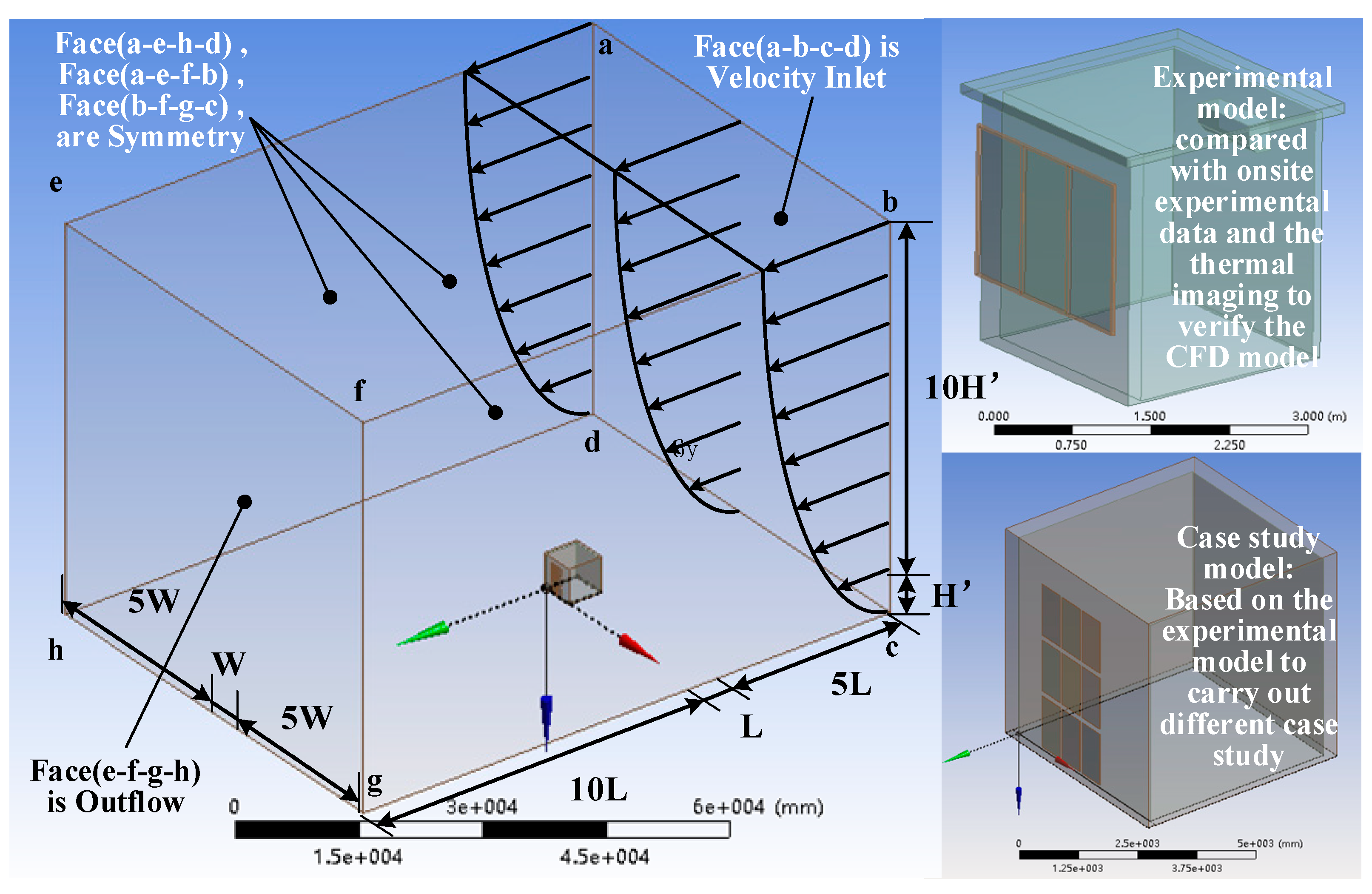
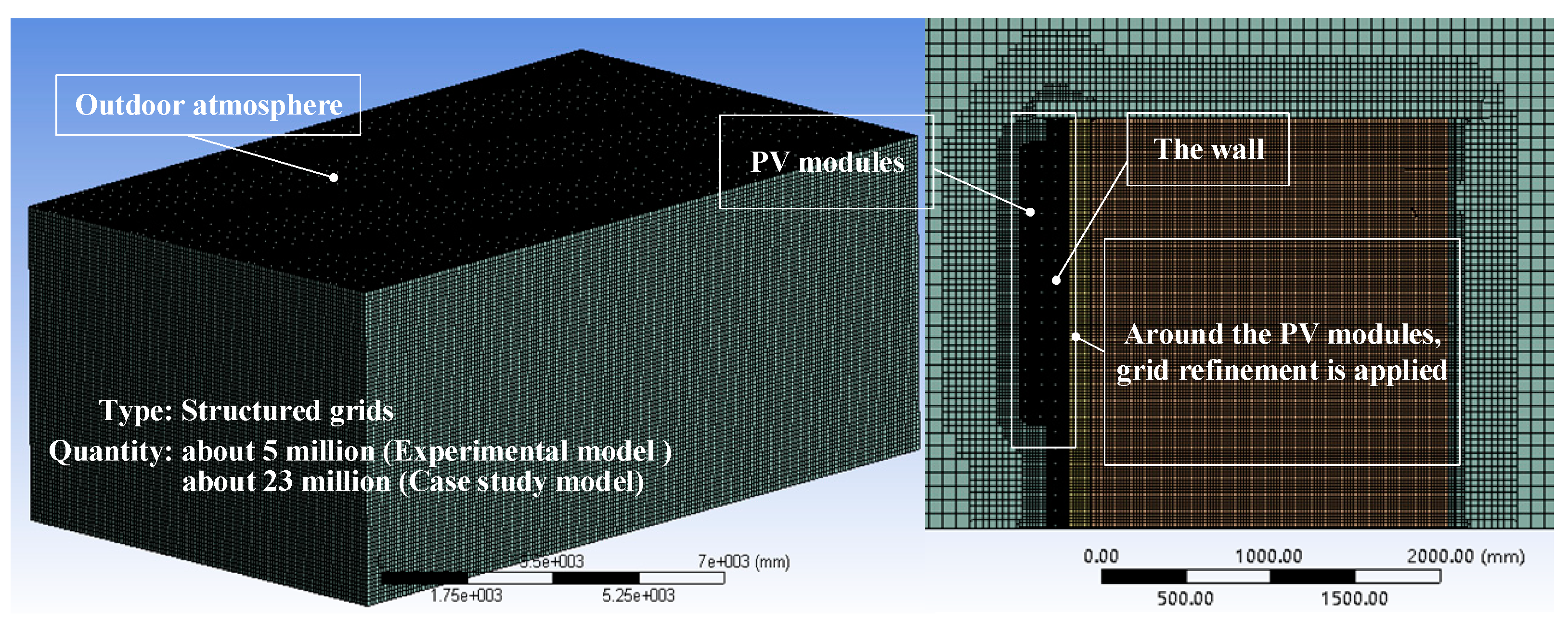

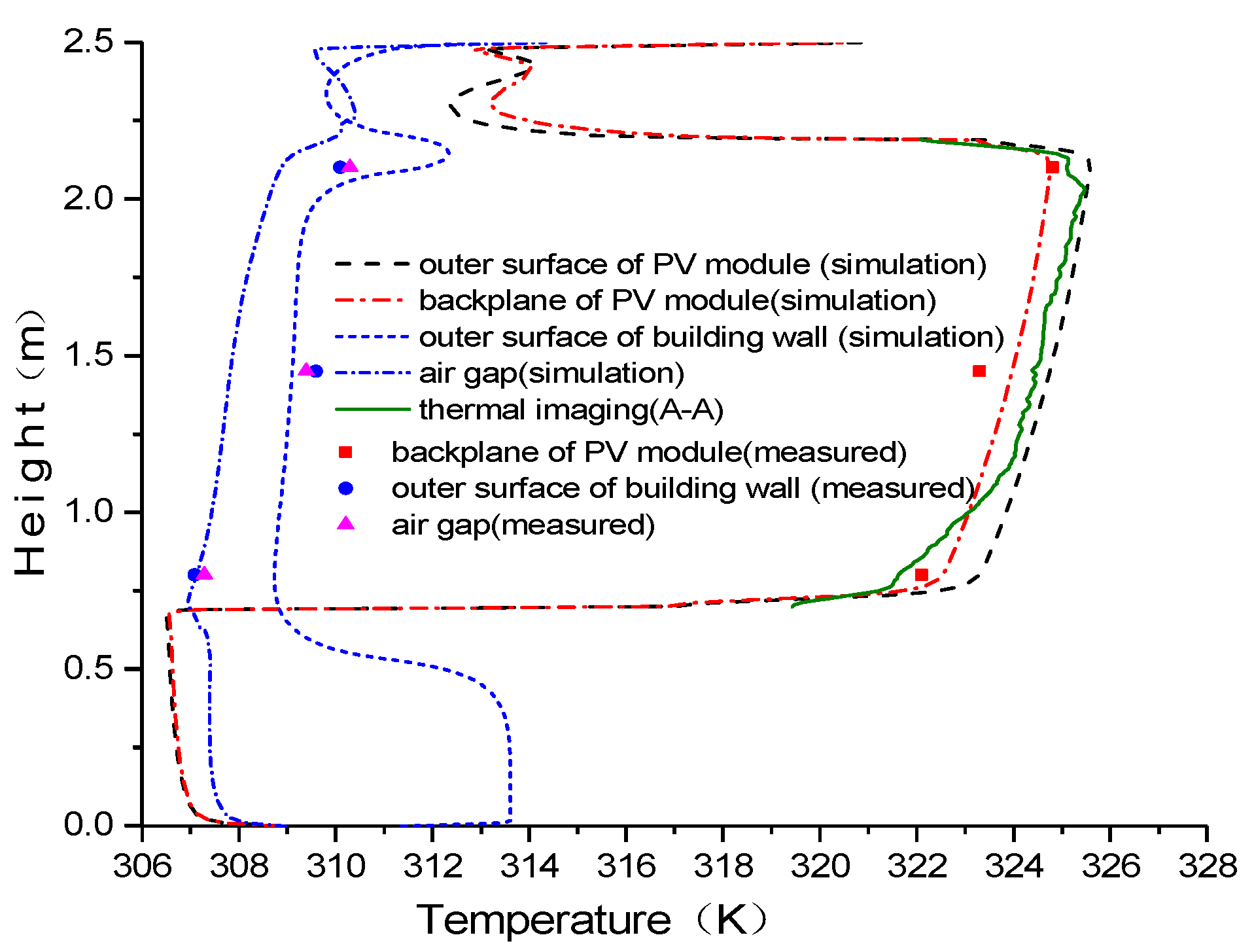

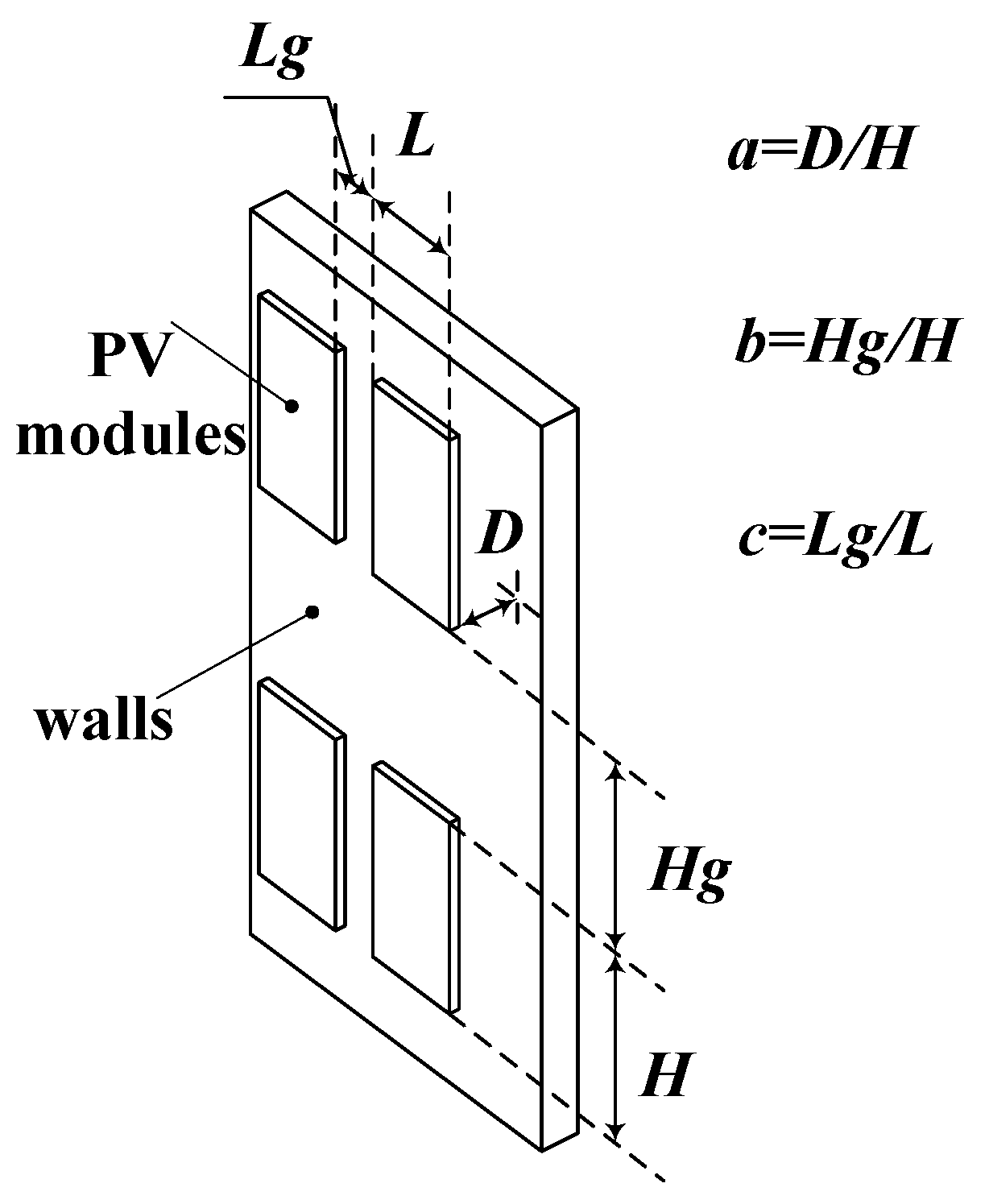
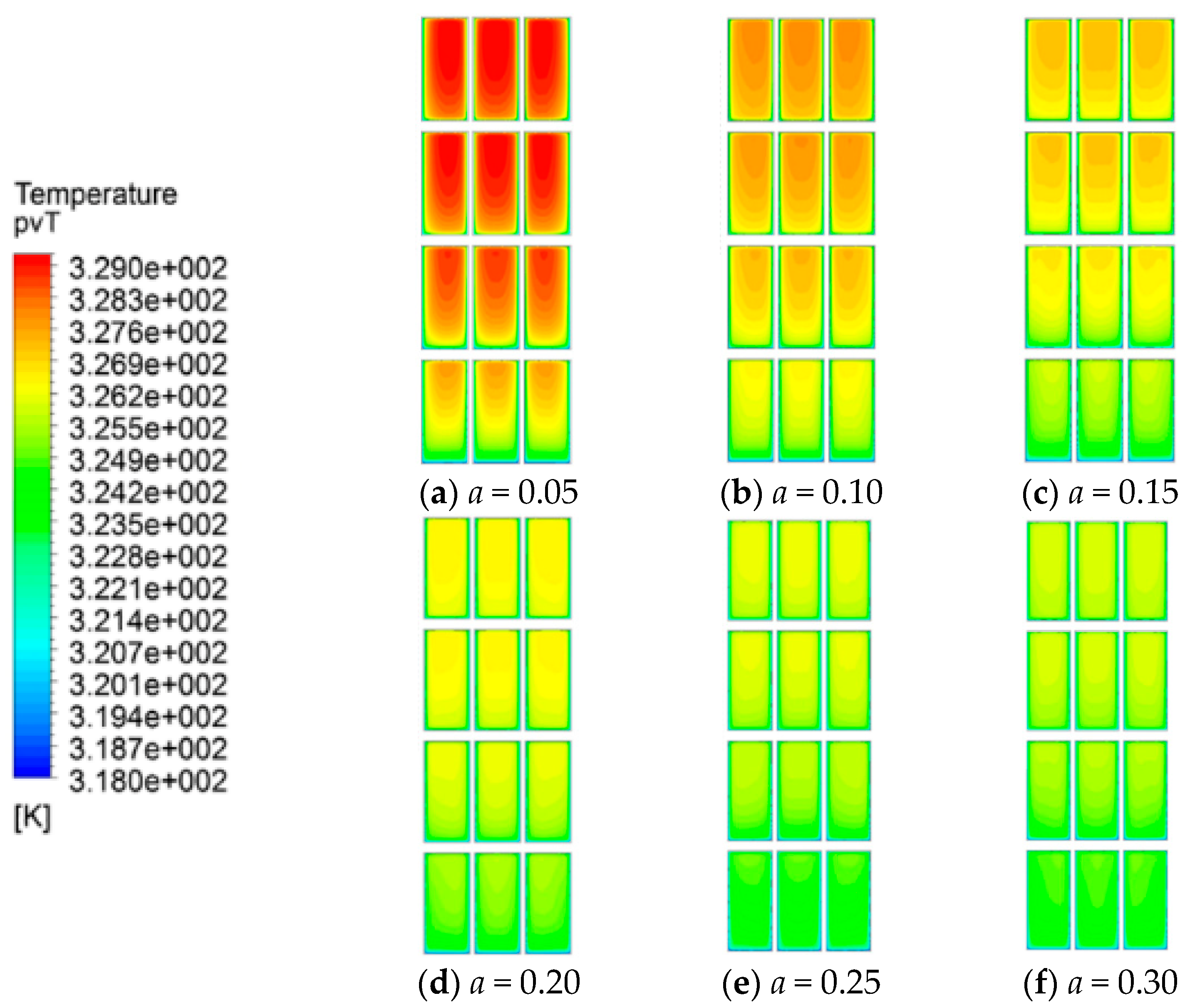
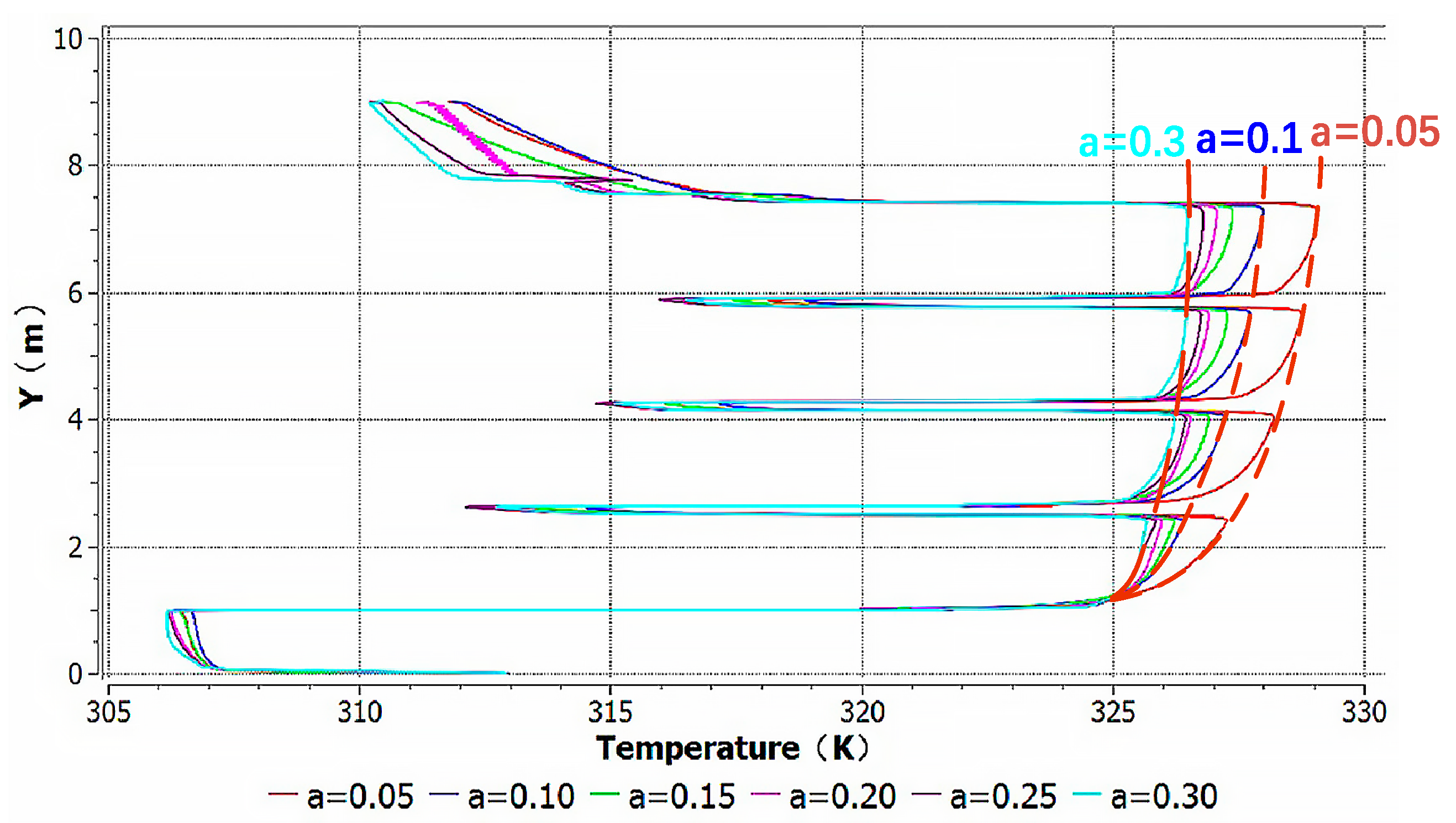
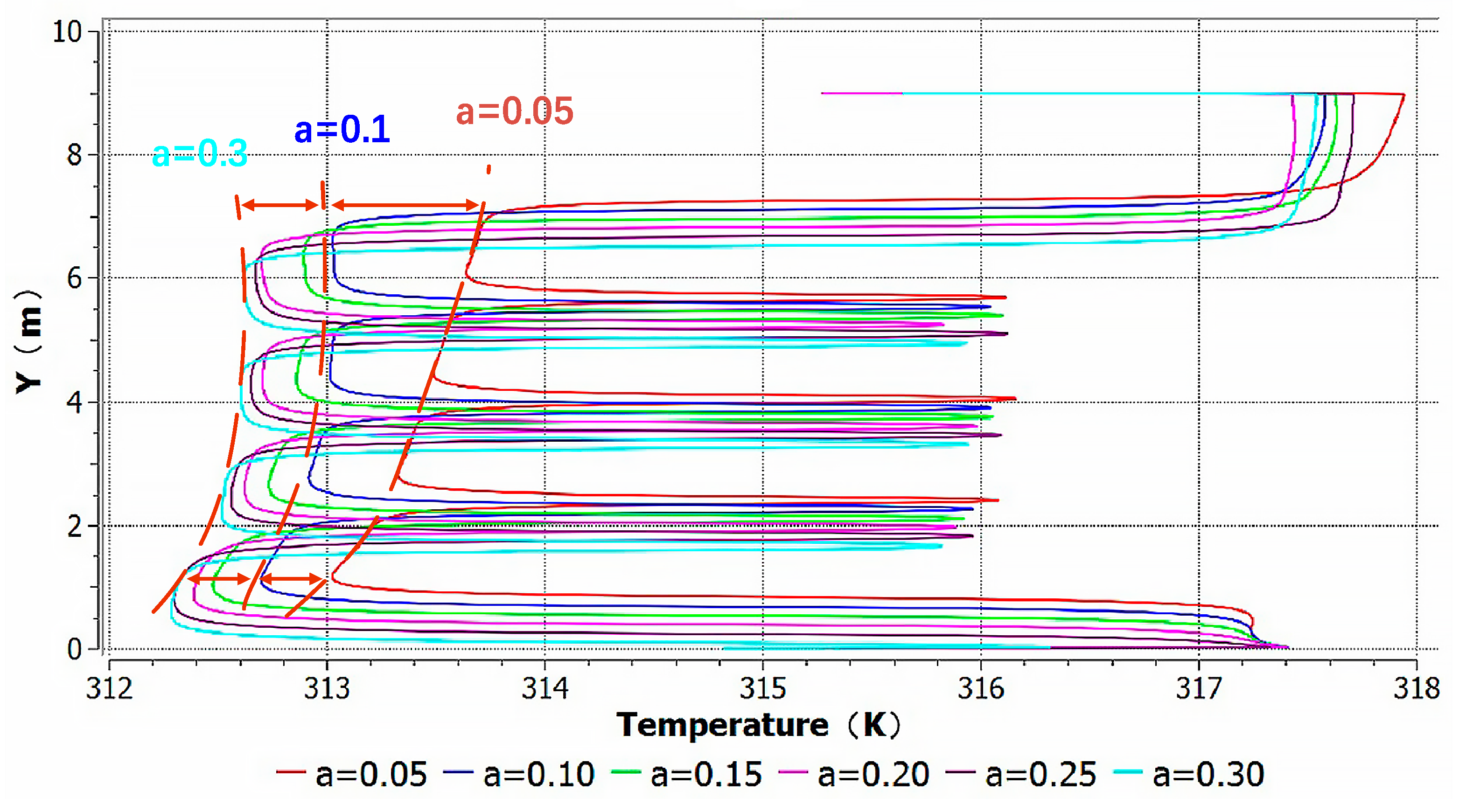
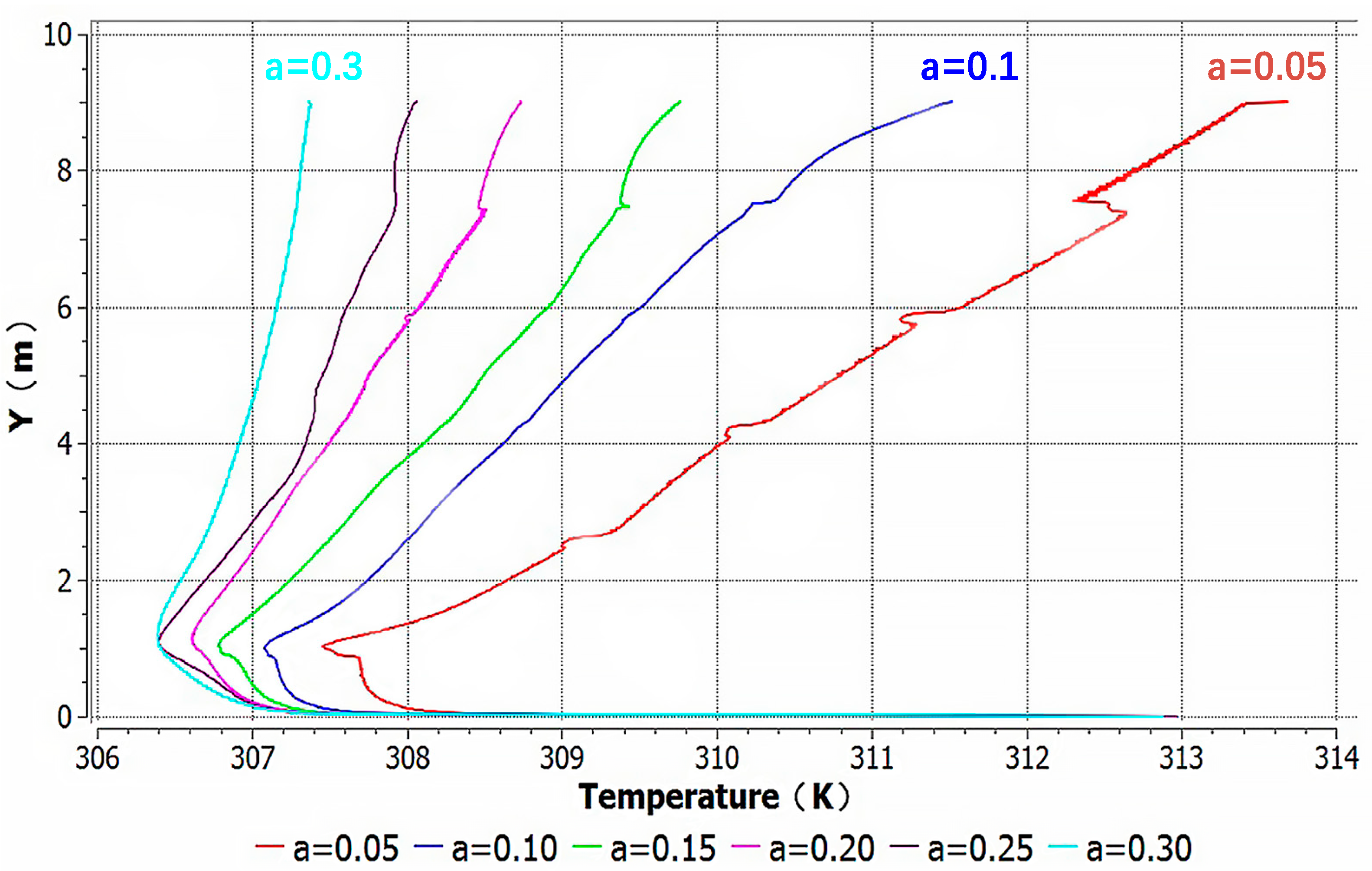
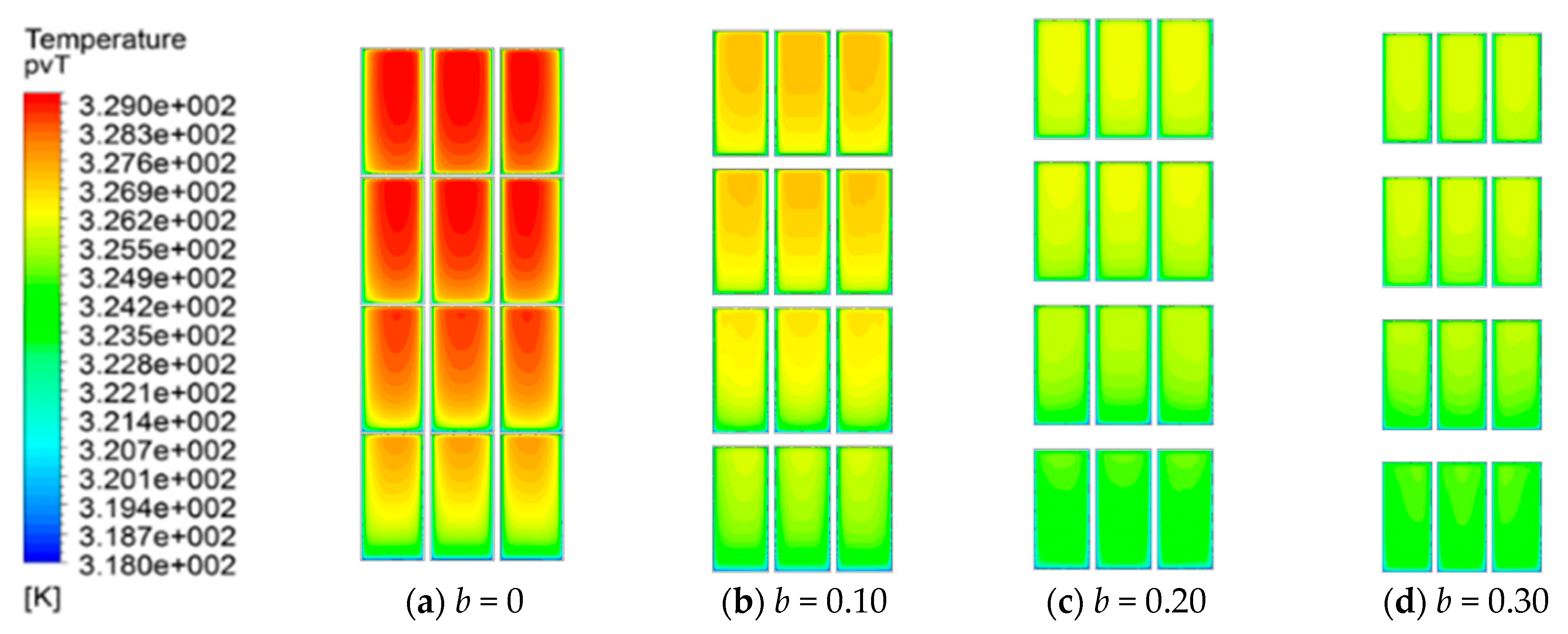


| Wind Velocity | Wind Direction | Outdoor Temperature | Atmospheric Pressure | Total Radiation | Diffuse Radiation |
|---|---|---|---|---|---|
| 2.0 m/s | 170 | 33.1 ℃ | 100.3 kPa | 715.4 W/m2 | 172.3 W/m2 |
| Name | Type | Accuracy | Temperature Range | Others |
|---|---|---|---|---|
| Thermal resistance | Pt100 | A class (±0.15 + 0.002 °C) | −50–200 °C | - |
| Thermal imaging equipment | NEC R300SR | ±1.0 °C | −40–500 ℃ | Temperature resolution: 0.03 °C |
| Height(m) | Project | Back Surface of PV Module | Outer Surface of Wall | Air Gap |
|---|---|---|---|---|
| 0.80 | measured (K) | 322.10 | 305.10 | 308.50 |
| simulated (K) | 322.53 | 308.73 | 307.12 | |
| 1.45 | measured (K) | 323.30 | 309.30 | 309.40 |
| simulated (K) | 323.97 | 309.10 | 307.83 | |
| 2.10 | measured (K) | 323.90 | 310.10 | 310.30 |
| simulated (K) | 324.76 | 311.71 | 308.87 | |
| Mean absolute error (K) | 0.65 | 1.81 | 1.46 | |
Publisher’s Note: MDPI stays neutral with regard to jurisdictional claims in published maps and institutional affiliations. |
© 2021 by the authors. Licensee MDPI, Basel, Switzerland. This article is an open access article distributed under the terms and conditions of the Creative Commons Attribution (CC BY) license (https://creativecommons.org/licenses/by/4.0/).
Share and Cite
Zhang, W.; Gong, T.; Ma, S.; Zhou, J.; Zhao, Y. Study on the Influence of Mounting Dimensions of PV Array on Module Temperature in Open-Joint Photovoltaic Ventilated Double-Skin Façades. Sustainability 2021, 13, 5027. https://doi.org/10.3390/su13095027
Zhang W, Gong T, Ma S, Zhou J, Zhao Y. Study on the Influence of Mounting Dimensions of PV Array on Module Temperature in Open-Joint Photovoltaic Ventilated Double-Skin Façades. Sustainability. 2021; 13(9):5027. https://doi.org/10.3390/su13095027
Chicago/Turabian StyleZhang, Wenjie, Tongdan Gong, Shengbing Ma, Jianwei Zhou, and Yingbo Zhao. 2021. "Study on the Influence of Mounting Dimensions of PV Array on Module Temperature in Open-Joint Photovoltaic Ventilated Double-Skin Façades" Sustainability 13, no. 9: 5027. https://doi.org/10.3390/su13095027






